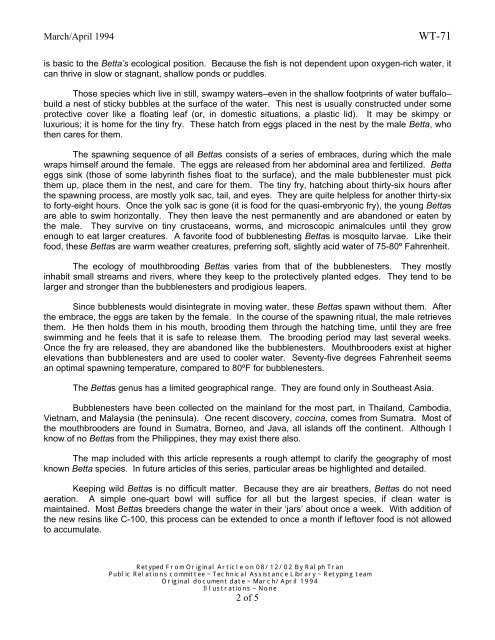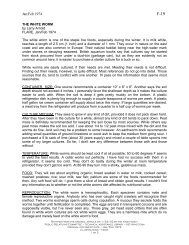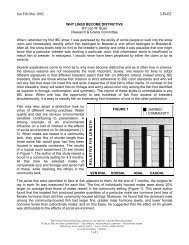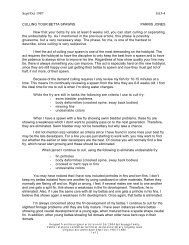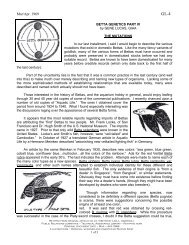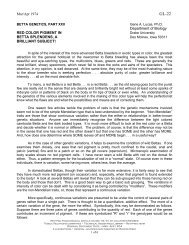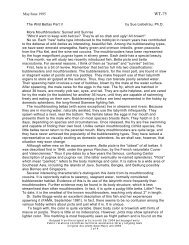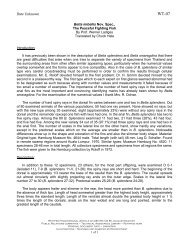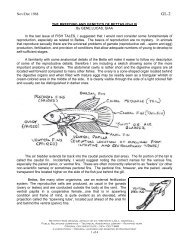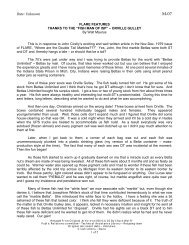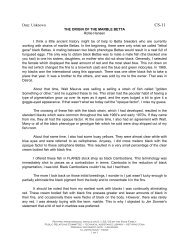WT-71: The Wild Bettas â Part 1 - International Betta Congress
WT-71: The Wild Bettas â Part 1 - International Betta Congress
WT-71: The Wild Bettas â Part 1 - International Betta Congress
Create successful ePaper yourself
Turn your PDF publications into a flip-book with our unique Google optimized e-Paper software.
March/April 1994<br />
<strong>WT</strong>-<strong>71</strong><br />
is basic to the <strong>Betta</strong>’s ecological position. Because the fish is not dependent upon oxygen-rich water, it<br />
can thrive in slow or stagnant, shallow ponds or puddles.<br />
Those species which live in still, swampy waters–even in the shallow footprints of water buffalo–<br />
build a nest of sticky bubbles at the surface of the water. This nest is usually constructed under some<br />
protective cover like a floating leaf (or, in domestic situations, a plastic lid). It may be skimpy or<br />
luxurious; it is home for the tiny fry. <strong>The</strong>se hatch from eggs placed in the nest by the male <strong>Betta</strong>, who<br />
then cares for them.<br />
<strong>The</strong> spawning sequence of all <strong><strong>Betta</strong>s</strong> consists of a series of embraces, during which the male<br />
wraps himself around the female. <strong>The</strong> eggs are released from her abdominal area and fertilized. <strong>Betta</strong><br />
eggs sink (those of some labyrinth fishes float to the surface), and the male bubblenester must pick<br />
them up, place them in the nest, and care for them. <strong>The</strong> tiny fry, hatching about thirty-six hours after<br />
the spawning process, are mostly yolk sac, tail, and eyes. <strong>The</strong>y are quite helpless for another thirty-six<br />
to forty-eight hours. Once the yolk sac is gone (it is food for the quasi-embryonic fry), the young <strong><strong>Betta</strong>s</strong><br />
are able to swim horizontally. <strong>The</strong>y then leave the nest permanently and are abandoned or eaten by<br />
the male. <strong>The</strong>y survive on tiny crustaceans, worms, and microscopic animalcules until they grow<br />
enough to eat larger creatures. A favorite food of bubblenesting <strong><strong>Betta</strong>s</strong> is mosquito larvae. Like their<br />
food, these <strong><strong>Betta</strong>s</strong> are warm weather creatures, preferring soft, slightly acid water of 75-80º Fahrenheit.<br />
<strong>The</strong> ecology of mouthbrooding <strong><strong>Betta</strong>s</strong> varies from that of the bubblenesters. <strong>The</strong>y mostly<br />
inhabit small streams and rivers, where they keep to the protectively planted edges. <strong>The</strong>y tend to be<br />
larger and stronger than the bubblenesters and prodigious leapers.<br />
Since bubblenests would disintegrate in moving water, these <strong><strong>Betta</strong>s</strong> spawn without them. After<br />
the embrace, the eggs are taken by the female. In the course of the spawning ritual, the male retrieves<br />
them. He then holds them in his mouth, brooding them through the hatching time, until they are free<br />
swimming and he feels that it is safe to release them. <strong>The</strong> brooding period may last several weeks.<br />
Once the fry are released, they are abandoned like the bubblenesters. Mouthbrooders exist at higher<br />
elevations than bubblenesters and are used to cooler water. Seventy-five degrees Fahrenheit seems<br />
an optimal spawning temperature, compared to 80ºF for bubblenesters.<br />
<strong>The</strong> <strong><strong>Betta</strong>s</strong> genus has a limited geographical range. <strong>The</strong>y are found only in Southeast Asia.<br />
Bubblenesters have been collected on the mainland for the most part, in Thailand, Cambodia,<br />
Vietnam, and Malaysia (the peninsula). One recent discovery, coccina, comes from Sumatra. Most of<br />
the mouthbrooders are found in Sumatra, Borneo, and Java, all islands off the continent. Although I<br />
know of no <strong><strong>Betta</strong>s</strong> from the Philippines, they may exist there also.<br />
<strong>The</strong> map included with this article represents a rough attempt to clarify the geography of most<br />
known <strong>Betta</strong> species. In future articles of this series, particular areas be highlighted and detailed.<br />
Keeping wild <strong><strong>Betta</strong>s</strong> is no difficult matter. Because they are air breathers, <strong><strong>Betta</strong>s</strong> do not need<br />
aeration. A simple one-quart bowl will suffice for all but the largest species, if clean water is<br />
maintained. Most <strong><strong>Betta</strong>s</strong> breeders change the water in their ‘jars’ about once a week. With addition of<br />
the new resins like C-100, this process can be extended to once a month if leftover food is not allowed<br />
to accumulate.<br />
Retyped From Original Article on 08/12/02 By Ralph Tran<br />
Public Relations committee ~ Technical Assistance Library ~ Retyping team<br />
Original document date ~ March/April 1994<br />
Illustrations ~ None<br />
2 of 5


